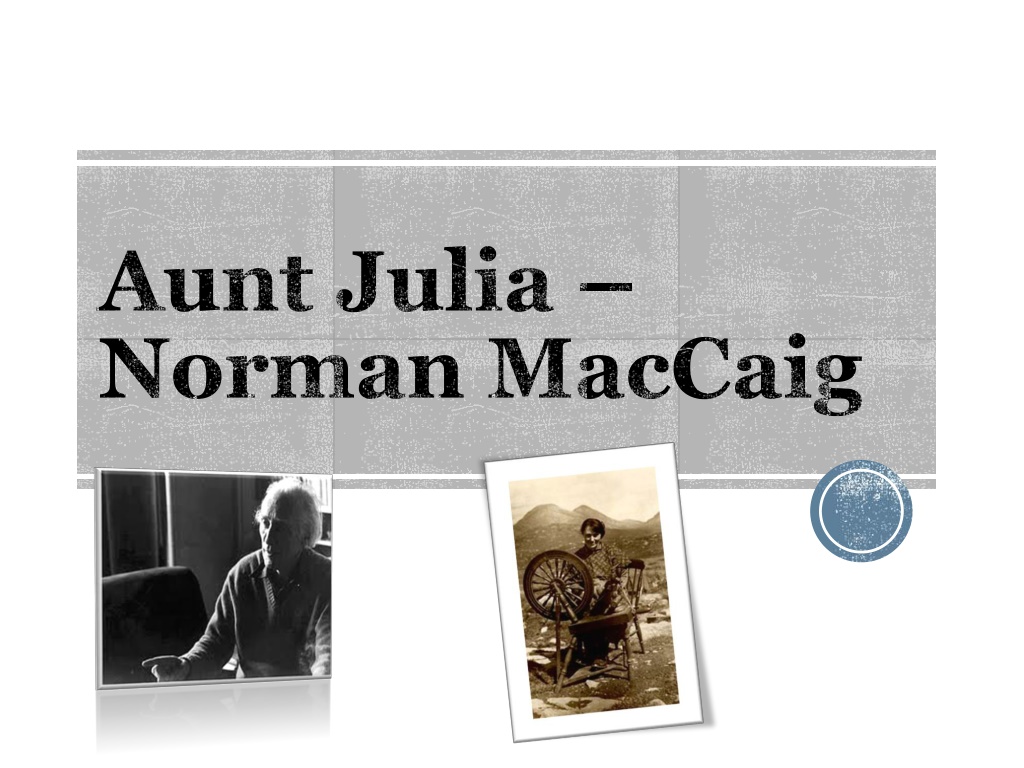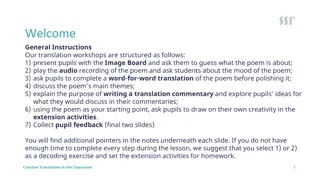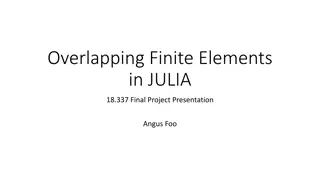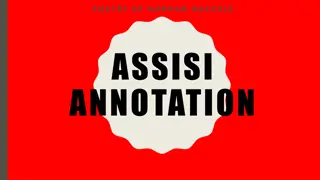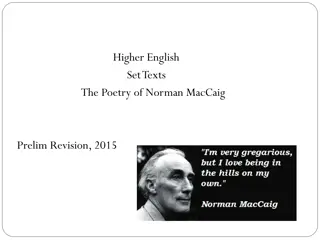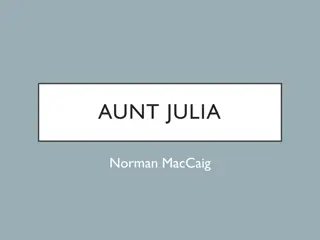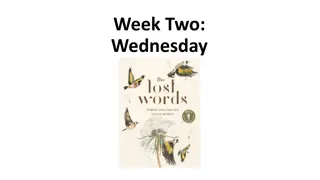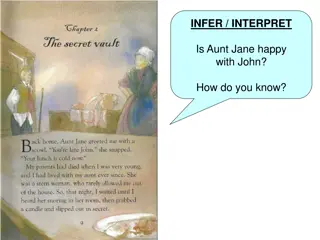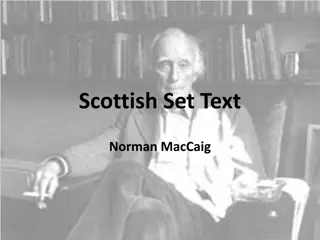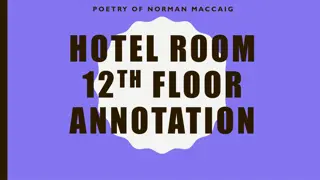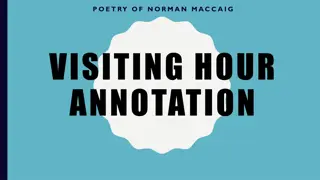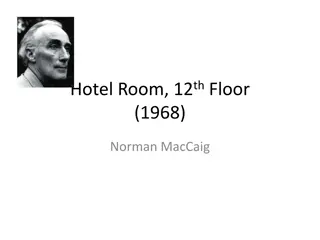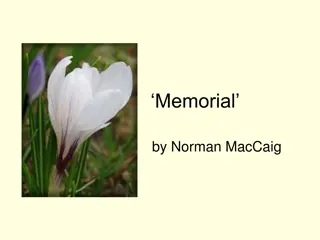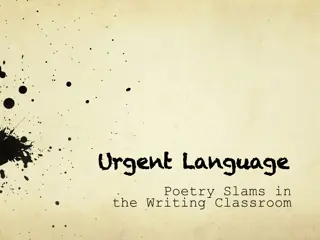Norman MacCaig's Poem "Aunt Julia
Norman MacCaig's poem "Aunt Julia" reflects his deep attachment to his Gaelic-speaking aunt who lived on a remote island. Despite the language barrier, the narrator expresses regret for not being able to communicate with her until after her passing. Through striking metaphors and a conversational style, MacCaig explores themes of regret, connection to nature, and the impact of missed opportunities for communication.
Download Presentation

Please find below an Image/Link to download the presentation.
The content on the website is provided AS IS for your information and personal use only. It may not be sold, licensed, or shared on other websites without obtaining consent from the author.If you encounter any issues during the download, it is possible that the publisher has removed the file from their server.
You are allowed to download the files provided on this website for personal or commercial use, subject to the condition that they are used lawfully. All files are the property of their respective owners.
The content on the website is provided AS IS for your information and personal use only. It may not be sold, licensed, or shared on other websites without obtaining consent from the author.
E N D
Presentation Transcript
Aunt Julia Norman MacCaig
We are learning to: We are learning to: annotate the text and identify the use of poetic techniques. Last poem folks!
Context of the poem Norman MacCaig's Aunt Julia lived on Scalpay, a small island off the coast of Harris in the Outer Hebrides. Aunt Julia lived a traditional, hardworking life on a croft and she spoke only her native Gaelic language. MacCaig sometimes described himself as three quarters Gaelic three of his grandparents were Gaels and his mother came from the same small island. He was born and brought up in Edinburgh, however, and knew Scalpay only from visits. He developed a deep affinity with the people, landscape and culture of Gaelic north-west Scotland from his visits there.
Context cont. As is evident in the poem, MacCaig felt a strong attachment to his Aunt Julia despite the language barrier that existed between them and this is one of the most memorable of his studies of Highland characters.
Representation of Aunt Julia Julia is next depicted in a series of striking metaphors that show how the young narrator connects her with elements of nature: with the earth, with water and with air. The last stanza introduces a tone of regret before ending with a picture of the larger than life character calling to him still getting angry, getting angry/with so many questions unanswered.
Tone of Regret The reason for this regret is that only after Julia's death did the poet learn enough Gaelic to be able to communicate with her. Hence all the questions that he would have asked to her must now remain unanswered, just as her questions to him as a child had been.
Form and Structure This is an autobiographical poem so it makes sense that the poet employs a first person narrative stance. Like all MacCaig poetry, part of its success lies in his skill of using accessible language in an incredibly skilful and effective way. Writing in free verse helps to create a conversational style and tone, while the use of enjambment and repetition allow him to emphasise key aspects of the poem.
Form and Structure cont. The poem is divided into five stanzas which each deal with a specific focus: Stanza 1 a child s memory of his aunt / main recollection is her language Gaelic which he could not understand. Stanza 5 by the time he learned some Gaelic, it was too late to communica te with his Aunt: she had died. Stanza 3 he recalls the strange experience of sleeping in a box bed. Stanza 2 describes his aunt and how she seemed strange to him, for example, barefoot or wearing men s boots / his descriptions give insights into her way of life. Stanza 4 vivid images capture aspects of her life e.g. carrying buckets of water as there is no running water.
Stanza 1 She was different, as Gaelic is not a common language. Aunt Julia spoke Gaelic Very loud and very fast. I could not answer her I could not understand her. She appears to be very extrovert and not shy. Repetition emphasises MacCaig s helplessness. This poem is in free verse verse which corresponds with aunt Julia s eccentricity and unpredictability. free Gaelic a Celtic language spoken in the highlands of Scotland
Stanza 1 The poem begins with a series of warmly drawn, affectionate childhood memories. Aunt Julia speaks Gaelic very loud and very fast. The speaker states I could not answer her, I could not understand her, immediately establishing one of the main themes - frustration at barriers in communication. However, despite this language barrier he goes onto draw a picture of a strong, capable and passionate woman who created a haven of safety and security in her house for the young boy.
Stanza 1 Clarity and lucidity were qualities MacCaig constantly worked for in his poetry and they are evident in this opening stanza with its series of straightforward statements. The poem has freshness and charm which stems from the fact it is with the eyes and ears of a child that he remembers Aunt Julia. The repetition of I could not reinforces the idea of the barrier in communication. However, despite this inability to understand or be understood, the tone is affectionate and emphasises that, even without a common language, strong bonds can be created. Already in this vivid description we have the impression of Julia as a dynamic, vigorous and forceful character.
Peat: an accumulation of partially decayed vegetation which forms in wetlands such as bogs Treadle: rocking lever operated by the foot to drive a spinning wheel Aunt Julia is quirky and unconventio nal She is burly, and shows a sense of power and strength. She wore men s boots When she wore any. - I can see her strong foot, Stained with peat, Paddling with the treadle of the spinning wheel While her right hand drew yarn Marvellously out of the air. Yarn: continuous twisted strand fibre produced on a spinning wheel. He is in awe of her and admires her. Stanza 2
Stanza 2 The poet begins to create a picture of a woman who lives a life close to the soil in this rural landscape. Her work is physically demanding, both out of doors and within her house. She is often barefoot but if shod, wears practical men's boots and the poet clearly admires her completing these tasks with capability. We see her engaged in one of the duties of her domestic life, spinning. This is a skill heavily associated with island life since Harris is famous for producing tweed.
Stanza 2 The long line paddling with the treadle of the spinning wheel serves to accentuate the lengthiness of the spinning process and creates a sense of movement and activity which MacCaig also associates with his aunt. In almost every description of her in the poem she is either in motion or speaking, emphasising the shocking silent finality of her death in the final stanza.
Stanza 2 As he continues to recall the spinning process, the description of her right hand drew yarn/marvellously out of the air conveys the air of magic or illusion about the task which was almost entrancing for the young boy watching. The long vowels in her hand drew yarn elongates the line and helps to convey the impression of the wool being stretched out and made taut. The use of the present tense throughout this stanza creates a sense of immediacy and shows how vividly and readily he can still access these memories.
Stanza 3 Despite the darkness and primitive accommodation, he feels secure and safe Hers was the only house Where I ve lain at night In the absolute darkness Of a box bed, listening to Crickets being friendly. No punctuation shows excitement. The darkness and friendly crickets contrast Box bed: bed built into a recess in a traditional Highland cottage, separated from the main room by a curtain or wooden panel.
Stanza 3 In stanza three we see clearly that the language barrier was surmounted by an instinctive bond between the speaker and his aunt. As a result the young boy feels safe and secure in the dark island of the box bed in Aunt Julia s home. It is enclosed and comforting and he vividly remembers lying in the absolute darkness listening to crickets being friendly. Again the affection he feels for her is evident in the decision to open this stanza with the pronoun Hers, emphasising her significance to him.
Stanza 4 She was buckets And water flouncing into them. She was winds pouring wetly Round house-ends. She was brown eggs, black skirts And a keeper of threepennybits In a tea pot. He compare to a series of metaphors to do with nature and things of a home (clothing and money) (clothing and money) nature Aunt Julia combines the Aunt Julia combines the strength of nature and the strength of nature and the security of a domestic home. security of a domestic home. It is a hard life, she did not have much money but worked very hard. Threepennybit: old eight-sided pre-decimal coin (worth around 1p)
Stanza 4 In stanza four, MacCaig employs personification to compare his aunt both with the elements he associates with this landscape, the wind and water, and within the objects and garments that for him are most evocative of her. She appears to him to be vivid, larger than life, and so connected with the landscape itself she becomes part of it. The observations are those of a child, fascinated by both the curious and the ordinary. In the poet's memory Julia becomes intertwined with the natural forces of wind and rain, in the description of the winds pouring wetly/round house-ends. At the same time he remembers her through a series of mundane domestic objects. She was buckets/and water flouncing into them and also brown eggs, black skirts/and a keeper of threepenny bits. Again the impression conveyed is of a woman in constant motion: the transferred epithet used in the flouncing water gives a description of the deliberate, vigorous way she moved.
Stanza 4 These metaphors seem to extend beyond merely describing Julia as an individual in order to use her as a symbol associated with, or representative of, the particular landscape, lifestyle and culture of this geographical area. Aunt Julia, then, epitomises the specific way of life of the crofting islanders who worked the land in a harsh, unforgiving climate. Despite the arduousness of this lifestyle, there is a pride and honesty in it, which the speaker obviously admires. Julia could even be taken to symbolise the land and elements themselves in this part of the world difficult at times, yet ultimately providing an honest, noble self-sufficient existence.
Stanza 5 It is too late by the time he had learnt his aunties language. He cannot communicate with her. Aunt Julia spoke Gaelic Very loud and very fast. By the time I had learned A little, she lay Silenced in the absolute black Of a sandy grave At Luskentyre. Death = Darkness Shorter lines with more pauses for thought. Change of atmosphere disappointment and sadness. Luskentyre tiny village with spectacular sandy beach on the island of Harris.
Stanza 5 Her words are incomprehensible. But she still lives through nature, as he still hears her through the seagull s voice . But I hear her still, welcoming me With a seagull s voice Across a hundred yards Of peatscrapes and lazybeds And getting angry, getting angry With so many questions unanswered. Both are getting angry. Aunt Julia is angry because he could not answer her questions. But he is frustrated because he could not get to know her better. Lazybeds: traditional way of growing crops in small patches of soil using ridges of soil.
Stanza 5 The final stanza opens by repeating the opening lines of the poem: Aunt Julia spoke Gaelic/very loud and very fast. However a darker tone enters the poem at this point. By the time MacCaig had learned a little Gaelic, his aunt was dead, lying silenced in her grave. The contrast between the loud, talkative vibrant Aunt Julia in life and the utter, absolute quiet of death is emphasised using enjambment to position silenced at the opening of line five. The tone seems almost accusatory, as if blaming death for suffocating and stopping her voice.
Stanza 5 This sinister, unsettling tone continues in describing the absolute black of her grave. Unlike the comforting security of the absolute darkness of the box bed in the third stanza, the subtle shift from darkness to black conveys the frighteningly bleak void of death. Instead of sustaining this melancholic, maudlin tone though, the speaker seems to challenge the finality of death in the line: But I hear her still, welcoming me/with a seagull s voice She has left such a strong impression on him he can still vividly imagine her calling to him in welcome. Her voice is loud, carrying across a hundred yards and shrill like a seagull s piercing cry. Again, the metaphor used connects her to the natural world which played such a huge part in her life. The poem ends with the poet imagining her: getting angry, getting angry, with so many questions, unanswered.
Stanza 5 The final word is left on a line of its own, serving to reinforce the speakers enduring sense of frustration. The ending of the poem is somewhat ambiguous and could be interpreted in a number of ways. The questions he alludes to could represent, literally, her questions to the boy, which he was unable to answer as he had no Gaelic, or they could represent all the questions he would have loved to ask but was unable to until it was too late. Moving beyond the literal, the questions could represent the more universal queries we all have about the meaning and mysteries of life itself. The repetition of the word angry in these final three lines suggests MacCaig is warning us to hold onto and cherish the culture and heritage of the island way of life. He is afraid if we allow it to die, like Aunt Julia, then it too will be lost forever.
